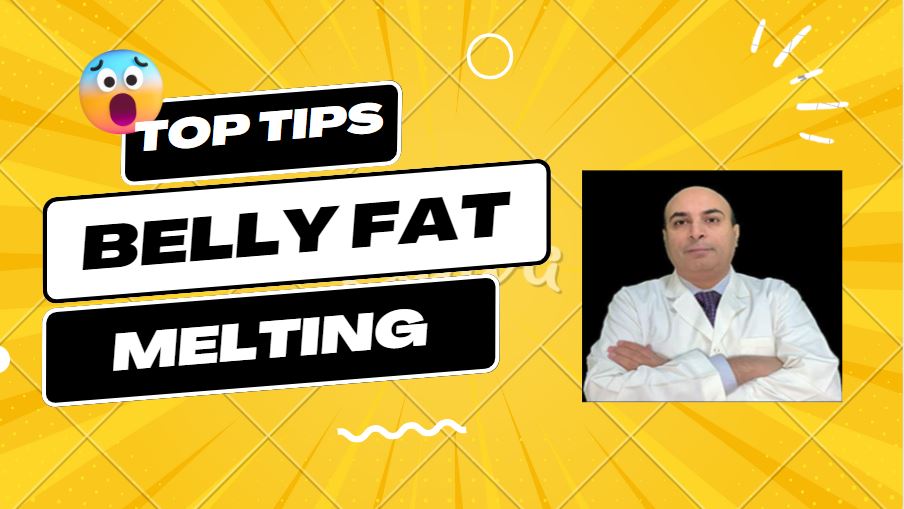Burning Away
Belly Fat: The Secrets Revealed
Do you have a little too much belly fat? If so, don’t worry – you’re not alone. Millions of people are struggling to get rid of their belly fat, and it can be a real challenge.
What Is Belly Fat and Is It Dangerous?
Visceral fat, also known as belly fat, is the layer of fat beneath your abdominal muscles. Belly fat provides a constant source of energy while also exposing the body to harmful toxins and hormones due to its critical location surrounding many of your vital organs.
When you have an excess of fat cells or they become too large, they can overproduce toxins that put you at risk for chronic inflammation, diabetes, heart disease, and cancer. For these reasons, belly fat is potentially more dangerous than subcutaneous fat, or the outer layer of fat that can be pinched with your fingers.
Best strategies to lose belly fat.
1. Target sugar
One good place to start improving your food choices is to eliminate sugary drinks, including juices. Because sugar increases belly fat and fiber decreases belly fat, juicing fruits removes the fiber, leaving only pure sugar. So, one quick and easy fix would be to stop drinking sugary drinks.
Replacing sugary beverages with water will significantly reduce your sugar intake, and once you've done that, you can figure out how to reduce your sugar intake from foods.
2. Eating a Mediterranean diet.
The Mediterranean diet emphasizes fruits, vegetables, legumes, and whole grains, with less ultra-processed foods and meat than a typical Western diet.
A Mediterranean diet benefits everything from the brain to heart health. Mediterranean foods are high in monounsaturated fatty acids (MUFA), which may help you lose belly fat. Olive oil, nuts and seeds, avocados, and fish are all high in MUFAs. Regular consumption of yogurt has also been shown to aid to reduce belly fat.
3. Front-load your meal
Begin your meal, especially your main course, with seasoned vegetables, whether it's vegetable soup or vegetables on your entrée plate. Remember that vegetables should always make up at least half of your plate and should be a mix of starchy (like potatoes) and non-starchy vegetables (your leafy greens, broccoli, etc.).
Because vegetable fiber is filling, eating vegetables first will leave less space for less healthy foods.
4. Commit to a physical lifestyle
The single most important thing people can do to prevent belly fat accumulation and eliminate existing belly fat is to commit to physical activity, and even better, a physical lifestyle. When men and women exercise, the first fat they lose is visceral fat.
In some ways, moderate-intensity physical activity is the "magic pill" that many people seek, because the health benefits extend beyond keeping your waistline trim: Physical activity not only lowers your risk of cancer, stroke, diabetes, and heart attacks but it has also shown in studies to significantly improve the moods of patients with major depressive disorders.
Overtraining, on the other hand, can be detrimental in the fight against belly fat because it can result in cortisol overproduction. Excess levels of this stress hormone have been linked to abdominal fat.
Walking briskly for an hour each day can help boost your metabolism, as can adding an incline to your treadmill routine.
5. Try cardio
Cardiovascular exercise, or cardio, stimulates the heart. It also burns calories, which aids in the reduction of body fat and the toning of muscles.
Walking is one type of cardio exercise.
- jogging
- riding a stationary bike
- water polo
6. Move around, and fidget.
Fidgeting is healthy, which is another fact that most people are probably unaware of. It is a significant means of calorie burning that is not physical exercise. If you are more jittery and active throughout the day in addition to exercising, you will experience better health outcomes. This includes simply moving around, tapping your foot, and gesturing while you speak.
7. Do not sit too much.
Studies show that people who sit for eight to nine hours a day do not benefit from exercise in the same way as those who are more active throughout the day, even if they complete the recommended 150 minutes of exercise each week.
If your job requires you to sit most of the day, try to find ways to move around: - Take quick walks throughout the day. - Go for a longer stroll while you're eating lunch.
Take the stairs, if possible, rather than the elevator. - Extend your legs while seated at your desk. - Try to move around as much as you can.
8. Get some sleep.
A recent study of 70,000 people found that those who got less than five hours of sleep were more likely to gain 30 pounds or more.
An essential part of losing weight is getting a good night's sleep, and when you don't get enough of it, two things happen:
- The Stress Hormone - Cortisol levels increase along with stress levels, which in turn increases appetite.
Because growth hormones are released by the body while you sleep, getting a bad night's sleep or not getting enough sleep lowers recovery and protein synthesis while also increasing stress hormone levels.
9. Build more muscle.
Sit-ups can help you burn calories, strengthen your core, and build muscle, but they cannot specifically "target" belly fat. The more muscle you have, the more calories you will burn at rest because muscle has a higher metabolic activity than fat.
After leaving the gym, you can continue to burn calories by using heavier weights and taking shorter breaks between reps.
You can achieve and maintain a healthier weight by burning those extra calories in addition to engaging in regular cardiovascular exercise and eating a balanced diet.
10. Eat fiber more.
You can feel fuller for longer by eating fiber-rich foods like chickpeas, lentils, and bananas. These foods contain a lot of soluble fiber, which when combined with water to form a gummy gel, slows the movement of food from the stomach to the intestines.
More fiber is also added to our diets when we eat a well-balanced diet full of whole grains, fruits, and vegetables.
11.Limit alcohol
Heavy drinkers may have more belly fat than social or casual drinkers, according to research.
Alcohol can lower your inhibitions in addition to adding additional calories to your diet.
If you consume more than two drinks per day, consider cutting back.
12. Fill Your Plate with Protein.
Every time you eat, include lean protein on your plate to help you feel full. Aim for at least 20 to 30 grams of protein per meal and 10 grams of protein per snack.
People who consume enough protein feel very satisfied and are less likely to seek out refined carbohydrates such as chips, cookies, cake, candies, or foods containing trans fats such as bakery pastries or French fries.
Make sure your meals contain protein. The choices include dairy, eggs, meat, fish, and beans.
Studies show that protein keeps you fuller for longer, reduces hunger hormone levels, and may even encourage you to eat less at your next meal.
13. Choose healthy carbs.
Carbohydrates get a bad rap. However, not all carbohydrates are bad. Instead of white bread, pasta, chips, and crackers, which have little fiber and can cause blood sugar spikes, opt for complex carbs such as 100% whole grain bread and pasta, brown rice, and beans.
14. Choose healthful fats.
There must be some dietary fat in a healthy diet, but not all sources of fat are advantageous.
In addition to raising the risk of heart disease and stroke, saturated and trans fats are bad for the heart.
They can also cause an increase in body weight and the formation of more visceral fat.
On the other hand, consuming healthy fats has several advantages, including the ability to help lower overall body fat.
Avocados, chia seeds, eggs, and fatty fish are all examples of healthy high-fat foods. - nut butter and nuts – olives.
FAQs
Is there really ‘one trick’ to losing belly fat?
When it comes to losing belly fat, there is no one-size-fits-all solution. Everyone’s body is different, and the best way to lose belly fat for one person may not be the same for another. That said, there are certain lifestyle changes that can be made to improve your overall health and help reduce excess abdominal fat.
Eating a balanced diet of lean protein, complex carbohydrates, healthy fats and plenty of fruits and vegetables is key in any weight-loss plan. Additionally, regular exercise is essential for burning calories and building muscle.
For maximum results, aim for at least 30 minutes of cardio five days a week combined with resistance training on alternating days. It takes dedication and consistency to see results but making these small changes can have a big impact on your waistline!
How do I know if I have visceral fat?
Visceral fat is a type of body fat that accumulates in and around the abdominal organs. It is considered to be the most dangerous type of fat, as it can lead to obesity and other health problems. To know if you have visceral fat, you should measure your waist circumference and BMI (Body Mass Index).
If your waist circumference is greater than 35 inches for women or 40 inches for men, or if your BMI is higher than 30, then chances are you have some visceral fat. Additionally, you may experience symptoms such as difficulty breathing while lying flat, excessive fatigue after physical activity, and an increase in abdominal girth due to bloating when you have too much visceral fat.
If you suspect that you may have high levels of visceral fat, it’s important to speak with your doctor about it so they can evaluate your overall health and suggest appropriate lifestyle changes.
What's the best way to burn belly fat if you're over 40?
If you’re over 40 and looking to burn belly fat, the best way to go about it is to combine diet and exercise. Diet-wise, focus on eating lean proteins, healthy fats, plenty of fruits and vegetables, and whole grains. Be sure to keep your calorie intake in check so that you’re not overeating.
Exercise-wise, aim for a combination of aerobic activities like walking or swimming as well as strength training exercises like weight lifting or bodyweight exercises. Incorporating both cardio and strength training into your routine will help you build muscle while burning fat. Finally, be sure to get enough sleep as this will also help your body maintain optimal health for burning belly fat.
How do you measure whether you're losing belly fat?
Measuring whether you're losing belly fat can be done in a few ways. First, it's important to determine your body fat percentage and waist circumference. Research shows that those who are considered obese may need to lose belly fat before they focus on general weight loss.
To achieve this, one must burn more calories than one consumes each day and incorporate foods that burn belly fat into their diet. Eating foods such as fish, nuts, fruits, and vegetables can help increase the rate of fat loss in the abdomen area. Additionally, regular exercise can help accelerate the process of burning calories and losing belly fat. Therefore, it's best to research what works for you and create a plan to measure your progress over time.
Summary
If you stick to this advises, for sure you will get rid of your belly fat in a very short time.

